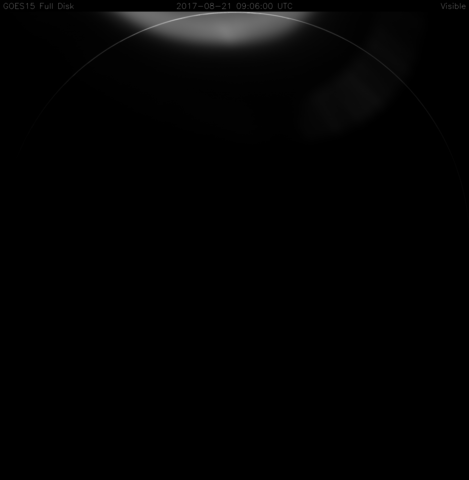Tools to work with signals and files from GOES satellites.
- goesrecv: Demodulate and decode signal into packet stream.
- goeslrit: Assemble LRIT files from packet stream.
- goesproc: Process LRIT files into plain files and images.
I started writing this to learn about things involved in the GOES
communication pipeline and in the process learn more about space
communication standards. Everything is written in C++ to strike a
balance between usability (no need for yet another hash table in C)
and performance. Eventually it would be nice to run the entire RX
pipeline on a little ARM board. The entire RX pipeline can run on a
Raspberry Pi 3.
System dependencies:
- CMake
- C++14 compiler
- OpenCV 2 (for image processing in goesproc)
- zlib (for EMWIN decompression)
Bundled dependencies:
- libcorrect (currently a fork with CMake related fixes)
- libaec
git clone https://github.com/pietern/goestools
cd goestools
mkdir -p build
cd build
cmake ../ -DCMAKE_INSTALL_PREFIX=/usr/local
ls ./src/goesdec ./src/goesprocAs of February 2018 goesrecv only runs ARM processors with NEON extensions (such as the Raspberry Pi 3). Stay tuned for compilation instructions...
If you're interested in post-processed data (images, text files) then you can ignore
goeslritand only usegoesproc.
This tool can be used to turn a stream of packets into LRIT files. LRIT files can then be used by goesproc (or other tools, such as to generate usable images and text files, or for debugging purposes.
It can either read packets from files to process recorded data, or
subscribe to goesrecv process to work with live data.
To make it write LRIT files to disk, you have to specify the category
of files you are interested in. Run goeslrit --help for a list of
filtering options. To make it write ALL LRIT files it seems, run
goeslrit with the --all option.
The files must be specified in chronological order because they are read in order. Packets for a single LRIT file can span multiple packet files, so if they are not specified in chronological order some LRIT files will be dropped. Specifying a file glob in bash expands to an alphabetically sorted list of file names that match the pattern.
Example with files:
$ goeslrit --images /path/to/packets/packets-2018-02-28T*
Reading: /path/to/packets/packets-2018-02-28T00:00:00Z.raw
Writing: OR_ABI-L2-CMIPM1-M3C02_G16_s20180582358300_e20180582358358_c20180582358429.lrit (4004087 bytes)
Writing: OR_ABI-L2-CMIPM2-M3C07_G16_s20180590000000_e20180590000071_c20180590000108.lrit (254551 bytes)
...If goesrecv is running somewhere on your network, goeslrit can be
configured to subscribe to its packet publisher to process live data.
This is done with the --subscribe argument and it can take any valid
nanomsg address. Often this will be a TCP address
(tcp://<ip>:<port>, also see nn_tcp(7)), but if you happen
to run goesrecv on the same machine as goeslrit you can also use
the IPC transport mechanism (ipc://path/to/socket, also see
nn_ipc(7)).
Example with publisher:
$ goeslrit --images --subscribe tcp://1.2.3.4:5005
Writing: OR_ABI-L2-CMIPM1-M3C02_G16_s20180591958303_e20180591958360_c20180591958427.lrit (4004087 bytes)
Writing: OR_ABI-L2-CMIPM2-M3C07_G16_s20180592000003_e20180592000073_c20180592000110.lrit (254551 bytes)
...Usage: goesproc [OPTIONS] [path...]
Process stream of packets (VCDUs) or list of LRIT files.
Options:
-c, --config PATH Path to configuration file
-m, --mode [packet|lrit] Process stream of VCDU packets
or pre-assembled LRIT files
--help Show this help
If mode is set to packet, goesproc reads VCDU packets from the
specified path(s). To process real time data you can setup a pipe from
the decoder into goesproc (e.g. use /dev/stdin as path argument).
To process recorded data you can specify a list of files that contain
VCDU packets in chronological order.
If mode is set to lrit, goesproc finds all LRIT files in the specified
paths and processes them sequentially. You can specify a mix of files
and directories. Directory arguments expand into the files they
contain that match the glob '*.lrit*'. The complete list of LRIT files
is sorted according to their time stamp header prior to processing it.
An example goesproc configuration file can be found at ./etc/goesproc.conf.
For example, with the following configuration file:
[[handler]]
type = "image"
product = "goes15"
region = "fd"
channels = [ "VS" ]
crop = [ -2373, 2371, -1357, 1347 ]
filename = "GOES15_%r_%c_%t"Running goesproc against a directory with GOES-15 LRIT files:
$ goesproc --config example.conf --mode lrit ./out/images/goes15/fd
Writing ./GOES15_FD_VS_20170820-210600.png
Writing ./GOES15_FD_VS_20170821-000600.png
Writing ./GOES15_FD_VS_20170821-030600.png
Writing ./GOES15_FD_VS_20170821-060600.png
Writing ./GOES15_FD_VS_20170821-090600.png
Writing ./GOES15_FD_VS_20170821-120600.png
Writing ./GOES15_FD_VS_20170821-150600.png
Writing ./GOES15_FD_VS_20170821-180600.png
...You can now use these image files however you like. For example, to produce a GIF from 8 consecutive full disk images, you can use the following ImageMagick commands:
mogrify -resize '640x480>' *.png
convert -loop 0 -delay 50 *.png GOES15_FD_VS_20170821.gifBecause HRIT is similar to LRIT at a higher baud rate, documentation for LRIT is also relevant for HRIT. The documents below used to be hosted by NOAA until ~2020. They're mirrored here for posterity (thanks @gojimmypi; see #102).
Also, these blog series:
- https://web.archive.org/web/20150426214432/http://www.acasper.org/2011/10/24/goes-satellite-decoding/
- http://www.teske.net.br/lucas/2016/10/goes-satellite-hunt-part-1-antenna-system/
From the LRIT receiver specs:
The LRIT dissemination service is a Grade-2 service; therefore, the transmission of user data will be error controlled using Reed-Solomon coding as an outer code. The used Reed-Solomon code is (255,223) with an interleaving of I = 4.
Data must be transformed from Berlekamp's dual basis representation to conventional representation before we can run the Reed-Solomon algorithm provided by libcorrect.
Please refer to CCSDS 101.0-B-6 (Recommendation For Space Data System Standards: Telemetry Channel Coding) to read more about the Reed-Solomon specifics for this application, the dual basis representation, and how to transform data between conventional representation and dual basis representation.
Thanks to @lukasteske for building an open source demodulator and decoder (see Open Satellite Project). I used his code to verify my antenna system and as reference to cross check between the LRIT spec and his implementation.
